These are some of the projects currently underway in the region. For more information on any of them, please visit the contact links provided.
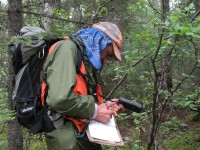 1. Biodiversity assessment for the Border Lakes Ecoregion. The Minnesota County Biological Survey (MCBS) is a statewide biological survey that is currently collecting and interpreting landscape, native plant community and species level data to determine existing areas of statewide biodiversity significance in the Border Lakes ecoregion of MN. Databases such as MN Taxa, the Releve database and the Natural Heritage Information System are available, as well as related conservation products and tools. Data from the Border Lakes ecoregion in Canada is also available from the Natural Heritage Information Centre (Ontario). Quetico Provincial Park is doing similar biological survey work. The Heart of the Continent Partnership facilitates collaboration and encourages technical assistance and public involvement in comprehensive, multi-use planning in areas of high conservation value.
1. Biodiversity assessment for the Border Lakes Ecoregion. The Minnesota County Biological Survey (MCBS) is a statewide biological survey that is currently collecting and interpreting landscape, native plant community and species level data to determine existing areas of statewide biodiversity significance in the Border Lakes ecoregion of MN. Databases such as MN Taxa, the Releve database and the Natural Heritage Information System are available, as well as related conservation products and tools. Data from the Border Lakes ecoregion in Canada is also available from the Natural Heritage Information Centre (Ontario). Quetico Provincial Park is doing similar biological survey work. The Heart of the Continent Partnership facilitates collaboration and encourages technical assistance and public involvement in comprehensive, multi-use planning in areas of high conservation value.
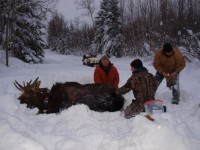 2. Moose in a warming world. Northwestern Minnesota’s moose population has declined from a population of several thousand in the late 1980s to fewer than 100. Generally high moose mortality is being recorded in the region, but details are poorly understood. The Natural Resources Research Institute leads this project, which seeks public participation in determining why moose are declining. The Moose Advisory Committee was formed by the
2. Moose in a warming world. Northwestern Minnesota’s moose population has declined from a population of several thousand in the late 1980s to fewer than 100. Generally high moose mortality is being recorded in the region, but details are poorly understood. The Natural Resources Research Institute leads this project, which seeks public participation in determining why moose are declining. The Moose Advisory Committee was formed by the 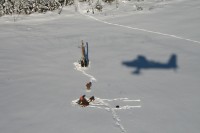 MN Department of Natural Resources at the directive of the State Legislature, and the Heart of the Continent Partnership is helping to coordiate other stakeholders for moose research in the region. Quetico Provincial Park is doing parallel moose studies, and is also involved in moose collaring, with a moose-tracking website.
MN Department of Natural Resources at the directive of the State Legislature, and the Heart of the Continent Partnership is helping to coordiate other stakeholders for moose research in the region. Quetico Provincial Park is doing parallel moose studies, and is also involved in moose collaring, with a moose-tracking website.
3. Invasive plants and forest restoration. How we look at ecological function of naturalized or potentially naturalized invasive species is changing. This project proposes to control non-native invasive plants on the Superior National Forest and in Voyageurs National Park using an integrated pest management approach. Sites where cabins have been removed in Voyageurs are being returned to a natural state by planting native plants and seeds. Other vectors for spread such as roadways, campgrounds, dispersed campsites, trails, and portages are currently treated on the Superior National Forest, with an Environmental Impact Statement underway for more treatment options in the BWCAW. Of course, climate change is part of the urgency to tackling the “new normal.” The Heart of the Continent Partnership is assisting with information dissemination to respond to this urgency.
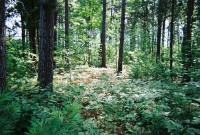 4. Boreal Forest and Community Resilience Project. Northern forests and communities face significant economic, environmental and social changes. What will happen as the climate shifts, people move, markets slow or insects attack? As we face uncertainty, what can we do to ensure a future that integrates healthy ecosystems, vibrant culture and stable economies? This project is led by the University of Minnesota and will promote community and ecosystem resilience in the context of uncertainty through diverse research and creative visioning and planning. The Heart of the Continent Partnership is assisting in new collaborations. [click to watch lecture by Peter Reich]
4. Boreal Forest and Community Resilience Project. Northern forests and communities face significant economic, environmental and social changes. What will happen as the climate shifts, people move, markets slow or insects attack? As we face uncertainty, what can we do to ensure a future that integrates healthy ecosystems, vibrant culture and stable economies? This project is led by the University of Minnesota and will promote community and ecosystem resilience in the context of uncertainty through diverse research and creative visioning and planning. The Heart of the Continent Partnership is assisting in new collaborations. [click to watch lecture by Peter Reich]
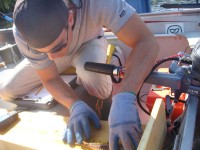 5. Lake sturgeon research at Voyageurs and Quetico parks. Sturgeon are present in all of the lakes in the Namakan Reservoir, in Rainy Lake and in Sturgeon Lake in Quetico Provincial Park. However, we have little understanding of population characteristics (for example, size and age class distribution) or spawning ecology (for example, where do sturgeon spawn and how often). The Namakan River, Ontario, appears to be the major spawning tributary for sturgeon in the Namakan Reservoir; and proposed hydroelectric facilities must be reviewed and evaluated based on good science and information.
5. Lake sturgeon research at Voyageurs and Quetico parks. Sturgeon are present in all of the lakes in the Namakan Reservoir, in Rainy Lake and in Sturgeon Lake in Quetico Provincial Park. However, we have little understanding of population characteristics (for example, size and age class distribution) or spawning ecology (for example, where do sturgeon spawn and how often). The Namakan River, Ontario, appears to be the major spawning tributary for sturgeon in the Namakan Reservoir; and proposed hydroelectric facilities must be reviewed and evaluated based on good science and information.
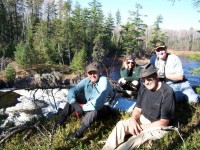 6. Modeling Visitor Flow at the Boundary Waters Canoe Area Wilderness – Since 1976, the Superior National Forest uses a visitor travel model to understand the effects of the allocation of entry-point-specific overnight trip permits on the number of visitors relative to the quota. The study is intended to be responsive to wilderness management needs. All overnight visitors who receive permits in 2011 will receive a survey specifically asking where they camped each night in the Boundary Waters Canoe Area Wilderness. The Forest Service is also monitoring service standards to validate the current travel model. This project is a collaborative effort among the Superior National Forest, the Rocky Mountain Research Station, Aldo Leopold Wilderness Research Institute (ALWRI), the University of Montana, Central Michigan University, and Christensen Research.
6. Modeling Visitor Flow at the Boundary Waters Canoe Area Wilderness – Since 1976, the Superior National Forest uses a visitor travel model to understand the effects of the allocation of entry-point-specific overnight trip permits on the number of visitors relative to the quota. The study is intended to be responsive to wilderness management needs. All overnight visitors who receive permits in 2011 will receive a survey specifically asking where they camped each night in the Boundary Waters Canoe Area Wilderness. The Forest Service is also monitoring service standards to validate the current travel model. This project is a collaborative effort among the Superior National Forest, the Rocky Mountain Research Station, Aldo Leopold Wilderness Research Institute (ALWRI), the University of Montana, Central Michigan University, and Christensen Research.
